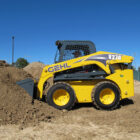Skid Loader
Skid loaders, often referred to as skid-steer loaders, are versatile machines commonly used in construction, landscaping, agriculture, mining, industrial, and forestry projects. These compact pieces of equipment are similar to compact track loaders, but they feature wheels instead of tracks.
One of the main advantages of skid loaders is their extensive range of attachments, making them highly adaptable for various tasks. While they are best known for lifting and transporting materials with buckets, they can also utilize popular attachments such as augers and brooms. This versatility attachment allows skid-steer loaders to perform functions like digging, grading, and much more.
Skid loaders come in a variety of sizes, including small, medium, and large frame options, as well as different rated operating capacities and engine sizes. You can typically choose between models that offer standard hand and foot controls, T-bar controls, or more advanced joystick controls.
What Size Skid-Steer Loader Do I Need?
To effectively begin your search for the ideal skid-steer loader, start by evaluating the scope of your workload. Identifying the amount of weight you need to lift and the required height will empower you to align the machine’s capabilities with your specific job needs.
Consider the benefits of opting for a loader with higher horsepower, as this can lead to increased productivity. Additionally, selecting a machine with higher hydraulic flow can optimize the performance of various attachments, such as hydraulic breakers, augers, and rotary cutters, allowing you to tackle tasks more efficiently.
To choose the right skid loader, what factors should I consider?
- Machine Size: Assess work area dimensions and limitations (weight, height, width).
- Undercarriage:
- Skid-steer loaders are suitable for paved or hard surfaces.
- Compact track loaders are ideal for sensitive surfaces, providing lower ground pressure and better traction for dirt work and soft terrain. They also perform well in wet climates.
- Rated Operating Capacity (ROC) and Horsepower:
- Determine ROC based on the materials and load size you need to carry.
- Ensure the machine can handle heavy loading, lifting, or digging.
- Lift Path:
- Vertical lift path offers more ROC and higher lift capacity at full height.
- Radius lift path provides maximum reach at eye level, useful for loading flatbed trucks.
- Options & Attachment:
- Control style: Choose between standard controls (T-bar/Hand-Foot) or Selectable Joystick Controls (SJC) with customizable patterns and features. A side-folding restraint bar and armrests with multiple adjustments enhance operator comfort and safety. The joystick and hand/foot control towers are fully adjustable for further customization of the cab.
- A/C & Enclosure Cabin: Consider a standard open cabin or an air-conditioned enclosure cabin for working in a harsh environment.
- Attachments: Match your application with standard-flow or high-flow attachments.
If you’re uncertain about how to choose the right skid loader, whether for renting or purchasing, reach out to Mayon Machinery today for expert consultation. At MMRI, we offer comprehensive maintenance packages and after-sales support nationwide in the Philippines to ensure your operations run smoothly.
Showing the single result




